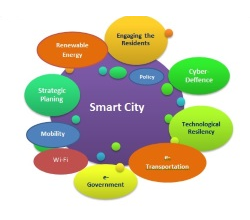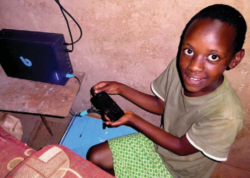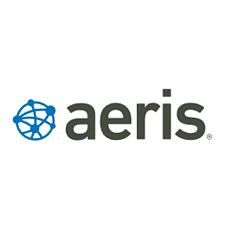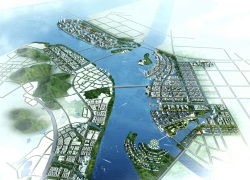The increasing urbanisation of populations is a trend that is set to continue and, while it has enhanced the economic wellbeing of millions of people, it has placed enormous demands on infrastructure and threatened the quality of life of inhabitants. The Internet of Things (IoT) provides a technical platform to enable cities to become smart by integrating ecosystems that offer efficiencies and cost savings, thereby mitigating the negative effects of increasing urban populations.
For city authorities, the concept of becoming smart through the deployment of IoT technologies is attractive because the barriers to entry are relatively low. In contrast to traditional infrastructure projects, IoT-based initiatives are relatively easy to install and operate because they often can work using existing equipment and structures. For example, a traffic light can become smart simply by attaching an IoTenabled wireless device to it and many other city assets, such as rubbish bins and street lighting, can be easily retrofitted with IoT hardware.
The number of smart city applications that can be enabled by IoT is, therefore, vast. Almost every aspect of smart city operations can be made smarter through IoT-enabled applications, which range from embedded devices in roadways for congestion management to applications that use IoT sensors to maximise limited water resources to advanced lighting. That means there is unlimited potential for IoT providers to deliver a variety of solutions to meet the ever-increasing demand.
New levels of networking
Smart devices that gather immense quantities of data, and communicate that data in real-time, require new levels of networking capabilities. These include:
Dedicated end-to-end connections
Legacy analogue networks cannot handle the amount of data traffic and the 24/7/365 usage demands of IoT applications. Digital remedies from telecoms carriers do work, but are built on a consumer infrastructure – with IoT communications added as an afterthought. What’s needed is a network dedicated exclusively to the unique requirements of IoT.
Ease-of-use with zero learning curves
There are so many components to a smart city that in-depth training and similar efforts take too long, cost too much and generally aren’t practical. Most workers have little or no technical knowledge so smart devices and their networks must be able to be configured and up and running out of the box.
Pay-as-you-go pricing
The dynamic nature of smart devices and their applications require flexible pricing structures. The traditional one-size-fits-all pricing models would make IoT systems cost prohibitive. In addition, city authorities want the comfort of not having to pay for mass-market usage of a service until that mass-market uptake arrives. Flexible pricing means they can pay more only as the number of users for their deployments grows.
Security
Security always is a top concern but, with smart cities, there are so many devices in diverse locations that the network always must be the first line of defence.
Future proofing
IoT technologies are changing constantly and cities cannot afford to be locked into obsolete solutions. That’s why a network infrastructure must take into account ever-increasing data loads, new device types added, and constant updates regarding a variety of unplanned events.
As smart city projects take off around the world, the question of how smart cities can turn into hubs that foster innovation is often asked. The truth is that we haven’t even started exploring the answers as many smart city initiatives currently are oriented towards solving the problems faced by citizens and other stakeholders. A fresh approach is therefore warranted to develop a clearly defined vision to turn smart cities into innovation enablers of the future.
Data is the place to begin
 Smart cities produce huge daily streams of data as citizens engage with web and/or mobile devices using connected networks. The significance of high-calibre data in empowering smart cities cannot be underestimated. Given this context, new approaches to integrate big data streams – from both sensors and networks – are needed in order to exploit the generated data for fine-tuning solutions, improving service delivery and better engaging stakeholders.
Smart cities produce huge daily streams of data as citizens engage with web and/or mobile devices using connected networks. The significance of high-calibre data in empowering smart cities cannot be underestimated. Given this context, new approaches to integrate big data streams – from both sensors and networks – are needed in order to exploit the generated data for fine-tuning solutions, improving service delivery and better engaging stakeholders.
Spatial and sentiment elements can be harvested at various levels from data streams and analysed separately for this purpose. The harvested data, minus details that might identify the source or reveal details of citizens, can be made available to approved entities that can use it to forecast trends and patterns associated with resource consumption, service use and others. Data collection and reporting, while promoting transparency, can improve stakeholder confidence in such projects.
The service angle
Every aspect of a smart city project offers ample scope for innovation. Take the citizen service area for instance. Constant innovation in improving services and stakeholder engagement can offer many benefits. A codified approach that outlines service cycles and identifies opportunities for improvement (OFIs) towards the end of each cycle can go a long way here. Incentives can be given to entities that evolve newer and more efficient service delivery mechanisms within a smart city project to address OFIs.
Policy intervention
Loosening regulations, offering incentives to R&D companies and easing small and medium enterprise (SME) access to non-debt financing, while providing tax incentives to companies who provide financing to start-ups, can be taken up. Policy makers need to orient themselves towards the greater goal of enabling the creation of special innovation zones housed in these smart cities.
Too big to fail?
No project should be allowed to run endlessly. But in the case of smart cities, as newer aspects get connected and monitored/measured, a project, hypothetically, could run forever. This is why smart cities need to have a crisp blueprint that spells out a clear roadmap to enable digitisation in phases in order of pre-determined priority. The road map should be accommodative enough to incorporate newer elements in terms of players and technology.
The tech-savvy urban population is more interested in information-driven connectivity, automation and digital interactions. With the massive adoption of smartphones, advancements in technology from 2G, 3G, to 4G/LTE, cellular connectivity is available everywhere, even in hard-to-reach areas. The connectivity-driven urban lifestyle enables smart initiatives across three core urbanisation areas: planning and management, infrastructure, and people.
Progressive cities already are responding to the challenges related to fiscal uncertainty, population growth, limited resources and climate instability, among others. Some city and national authorities are well advanced in their smart city activities, although the full fruition of the concept remains many years away for even the most advanced cities. Nevertheless, enquiries, research and trials are well underway and cities across the world are tying up with industry associations for consultation on technology-based smart solutions. It will be interesting to see how business organisations and government authorities strategically utilise IoT technologies, develop baseline targets and choose key performance indicators (KPIs) to further their smart city initiatives.
High-level global package tracking with data transparency
Typical waypoint track-and-trace solutions available from couriers and airlines offer limited transparency. Consumers and businesses only get updated when their packages have been scanned with a bar-code reader at certain stops along a route, which can be insufficient for the most valuable merchandise. And if a package gets lost, it can be very difficult for the item’s owner to get immediate updates. To bring complete peace of mind to organisations and individuals, tracking a package at every step of its journey, in real-time, becomes a business-critical requirement.
TrackerSense offers a low-cost solution for individuals and freight companies that need global, real-time tracking of high-value assets. The company’s devices use the latest GPS and location-based services technology to track packages anywhere in the world via the company’s web portal, which shows the item’s position at that moment. Transparency and additional information, such as temperature or exposure to shock, can be vital for sensitive shipments, so real-time tracking becomes mandatory.
With advances in cellular technology, TrackerSense can target the exact location of vital assets, thereby enabling quick and decisive action should a problem occur. The company relies heavily on an IoT partner to support these functions. High quality, robust GPS connections are critical, and competitive costs are important as well. To ensure growth and pricing consistency, TrackerSense required a way of ensuring low-cost services with complete visibility into package tracking.
“Working in partnership with Aeris allows us to track at a cost-effective price and, no matter how far-flung our customers’ packages are located, the power of Aeris makes lack of visibility a thing of the past,” says Wayne Soutter, the managing director of TrackerSense.
Tracking transparency and operational efficiency
With Aeris’ transparent pricing, TrackerSense was able to ensure that data costs were well managed, and it became simple to decipher where costs were originating. In addition, with AerPort, the Aeris IoT Services portal, TrackerSense now could see real-time data usage, as well as the precise location of devices. Powered by Aeris’ global SIMs, TrackerSense’s devices enable full tracking capabilities — with location alerts, tracking history and updated shipments reports.
With the Aeris IoT Services platform, TrackerSense now can combine the latest technologies in IoT connectivity with its tracking solutions to help ensure high-value assets are safe and secure. And with transparency of data consumption, limit alerts and visibility of financial impacts, Aeris helps TrackerSense increase operational efficiency, reduce theft and recover lost or stolen packages.
By tracking and monitoring any and all connected devices, managers can make smart decisions based on factual data. This business intelligence is driving performance and creating significant competitive advantages for agile tracking companies.
BBOXX— Energising the world
BBOXX designs, manufactures, distributes and finances innovative plug-and-play solar powered systems to improve access to energy across Africa and the developing world. The company recognises the importance of sustainable energy and aims to provide 20 million people with electricity by 2020.
Through a vast network of shops and outlets, BBOXX focuses on giving people, many in off-grid communities, access to electricity, while offering superior customer service. Its core products are a range of solar powered battery boxes that sit in a home and allow users to power small appliances, such as lights, mobile phones, refrigerators or computers.
Companies operating in the most remote locations, with products purpose-built for off-grid, rural and often challenging environments, require a reliable global mobile network that provides consistent connectivity worldwide to enable effortless remote monitoring of energy systems. To overcome these many life-critical, energy delivery issues, there is significant need for reliable GSM and CDMA connectivity to assist in the deliver functional, energy saving solutions.
 The World Energy Outlook estimated that 1.2 billion people, equivalent to 16% of the global population, did not have access to electricity in 2016, with many more people living with an electricity supply described as poor quality or unreliable. More than 95% of those living without electricity are in sub-Saharan Africa and developing Asia, 80% of which live in rural areas.
The World Energy Outlook estimated that 1.2 billion people, equivalent to 16% of the global population, did not have access to electricity in 2016, with many more people living with an electricity supply described as poor quality or unreliable. More than 95% of those living without electricity are in sub-Saharan Africa and developing Asia, 80% of which live in rural areas.
BBOXX needed to use real-time data to identify device issues early, with pro-active alerts sent to customer service agents to ensure that system problems could be fixed before they evolved. Because of this, the company required a reliable cellular network that enabled effortless remote monitoring and access to real-time data, as well as the ability to configure and adapt each system so as to maximise battery life and provide cost-effective solutions for both itself and its customers.
In addition, BBOXX products are manufactured without a known destination and, as such, with certain mobile network providers, a local SIM card would have to be inserted into the device following sale and then would require local configuration. This process required additional time, cost more and hindered operational effectiveness. Therefore, mass global deployment of solutions was only possible by working with a reliable cellular network partner that provided end-to-end monitoring, no matter where in the world systems are deployed.
Reliable network connectivity enables global deployment
Aeris IoT Services offers multiple, non-steered network connectivity in East and Central Africa, the principle areas where BBOXX deploys, thereby enabling real-time gathering of actionable data. Aeris’ global support of major cellular technology standards, such as GSM, CDMA and LTE, also ensured that BBOXX could deploy its devices in any location during its global expansion.
With the Aeris IoT Services platform, BBOXX can install the Aeris global subscriber identity module (SIM) at the point of manufacture, reducing both supply chain costs and deployment time. Also, by utilising Aeris’ single global access point name (APN), the solar-powered BBOXX system could be deployed on a simple plug-and-play basis, without the need to reconfigure to local network settings.
By utilising the Aeris connectivity management platform, AerPort, for IoT devices, BBOXX was able to have real-time access to data usage, alert management and device connectivity management over the SIM lifecycle.
 Aeris IoT Services’ network connectivity now enables BBOXX to remotely monitor its devices. Configuration and deployment times have been reduced significantly. Predictive and proactive maintenance help lower ownership and maintenance costs. And, these plug-and-play devices can be switched off from a central location if troubleshooting issues arise or if payments are not met. All this adds up to the lowest possible total cost of ownership (TCO) for an IoT solution.
Aeris IoT Services’ network connectivity now enables BBOXX to remotely monitor its devices. Configuration and deployment times have been reduced significantly. Predictive and proactive maintenance help lower ownership and maintenance costs. And, these plug-and-play devices can be switched off from a central location if troubleshooting issues arise or if payments are not met. All this adds up to the lowest possible total cost of ownership (TCO) for an IoT solution.










